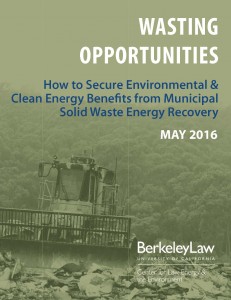Last night we had a spirited discussion on KALW’s “City Visions” on the prospects of turning the mountains of trash we’d otherwise send to landfills into energy. You can listen to the audio here.
My takeaway is that despite all our efforts to reduce, reuse and recycle, there will always be some (hopefully small) percentage of garbage that we simply cannot avoid sending to landfills. Some of that waste may be too complicated or expensive to reuse, from pizza boxes with glue to “urine-stained carpets,” as Rob White from Sierra Energy pointed out.
San Francisco is one of the national leaders in waste reduction policies, as Jack Macy described, and is able to address about 80-90% of its waste. But there’s a remaining 10 percent that may dwindle further but will still be shipped to landfills somewhere. At this point, hundreds of tons of garbage a day exit San Francisco for landfills.
 I understand the concern from environmental advocates that waste-to-energy facilities have polluted local communities and that the promised results haven’t been delivered.
I understand the concern from environmental advocates that waste-to-energy facilities have polluted local communities and that the promised results haven’t been delivered.
But as we argue in “Wasting Opportunities,” technologies have improved, and the state has an overriding interest in trying to figure out how to reduce landfilling and meet renewable energy goals. It would benefit all stakeholders to engage in a process to determine under what standards it might make sense to deploy some of these higher-performing technologies.
Not all waste-to-energy technologies will make the cut, but with proper, evidence-based analysis, some may shake out and provide environmental benefits. At that point, we can address the siting concerns to ensure low-income communities of color are not overburdened by deployment.
But if we don’t take action soon, the status quo on trash is simply not sustainable.
Every year, Californians send about 30 million tons of trash to landfills. While the state’s residents do their part to reduce, reuse and recycle, that’s still a whole lot of garbage. It’s not only a land use issue, it’s a climate change issue: as landfill waste decays, it emits methane, a powerful greenhouse gas.
 Many other countries and states are using energy recovery technologies to turn that trash into power. Mostly it’s done by heating and gasifying the material, now using more advanced and cleaner technologies to recover energy from this solid waste. California has three such facilities in operation. But since the 1980s we’ve essentially not allowed any new ones to be built, out of concern for local pollution impacts, particularly on low-income communities of color.
Many other countries and states are using energy recovery technologies to turn that trash into power. Mostly it’s done by heating and gasifying the material, now using more advanced and cleaner technologies to recover energy from this solid waste. California has three such facilities in operation. But since the 1980s we’ve essentially not allowed any new ones to be built, out of concern for local pollution impacts, particularly on low-income communities of color.
But as the energy recovery technology improves and the state grapples with its needs both to reduce greenhouse gas emissions and find non-fossil fuel-based sources of energy, waste-to-energy has emerged as an important issue in the Capitol recently.
To that end, Berkeley Law’s Center for Law, Energy and the Environment (CLEE) convened a group of environmental advocates, waste-to-energy technology developers, and state and local officials to discuss prospects for moving forward on this issue.
The concerns are significant: will the technologies adversely impact nearby communities, many of which may be disproportionately low-income and of color? Will energy recovery incentives discourage recycling? How reliable are these new technologies in reducing local emissions?
Based on that discussion, CLEE is today releasing the report Wasted Opportunities: How to Secure Environmental & Clean Energy Benefits From Municipal Solid Waste Energy Recovery, which I co-authored with Daniel Gergely Szabo. It recommends solutions for the state to address this challenge, including:
- The development of technology-neutral, performance-based standards for energy recovery of waste materials that will not discourage recycling;
- A revised waste disposal hierarchy that includes energy conversion that reduces overall pollution and contemplates “dispersion” as the lowest rung beyond disposal; and
- A revised landfill tipping fee that accounts for the full range of environmental costs.
Ultimately, should decision-makers identify appropriate technologies to deploy, the state will need a discussion on land-use siting to ensure that environmental justice concerns are addressed. While that process is not the subject of this report, it would be a worthwhile second step in contemplating these technologies.
You can read more on the report page here. In addition, I will be hosting a radio show discussion on this topic tonight at 7pm on San Francisco’s KALW radio 91.7 FM, a local NPR affiliate, for the show City Visions. My guests include:
- Jack Macy, Senior Commercial Zero Waste Coordinator for the City and County of San Francisco Department of the Environment;
- Rob White, Chief Strategist at Sierra Energy, a waste gasification and renewable energy company founded in Davis, California in 2004; and
- Heather Youngs, Senior Analysis Fellow at the Energy Biosciences Institute at the University of California, Berkeley and an adjunct professor of biochemistry at Michigan Technological University.
For those not in the area, you can tune in via the website, either live or afterwards when the audio is posted.


